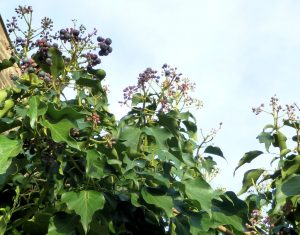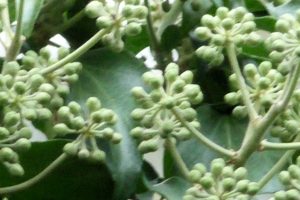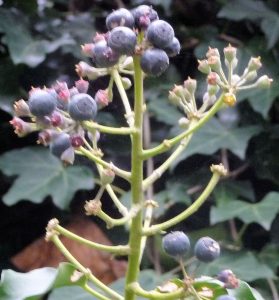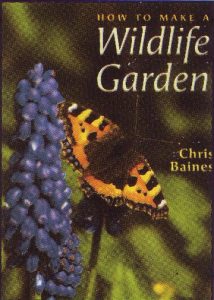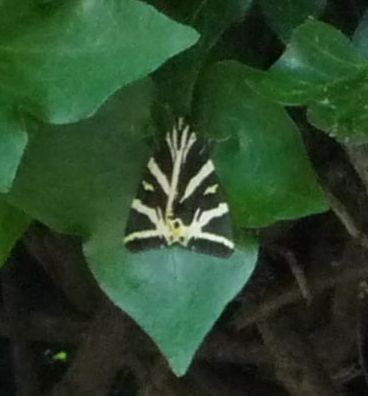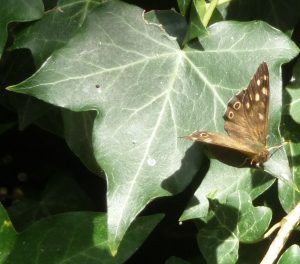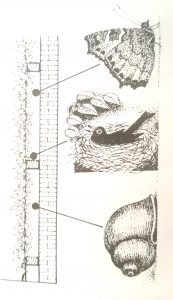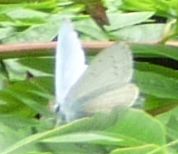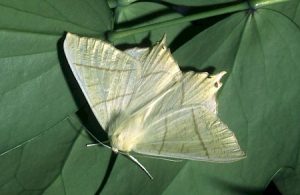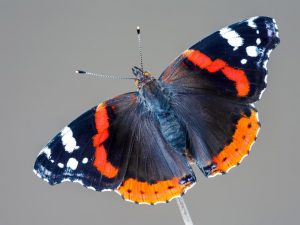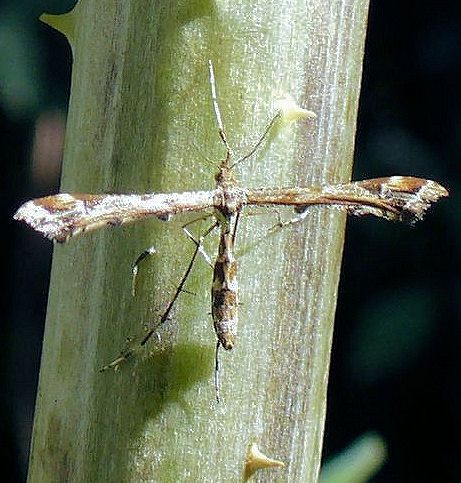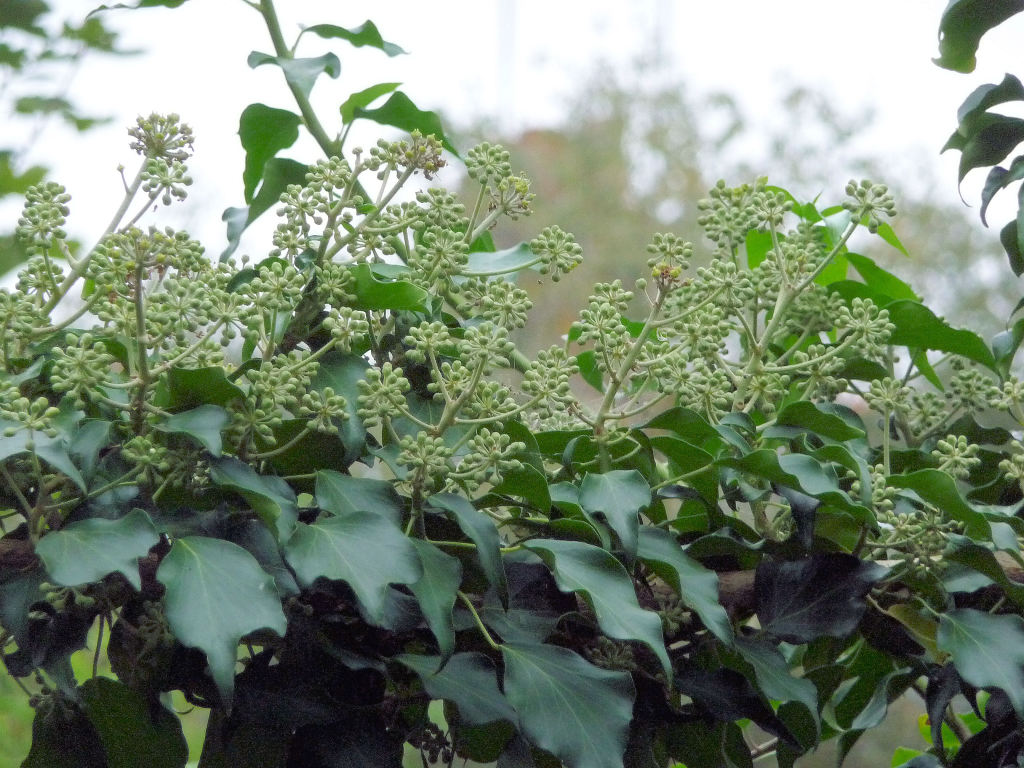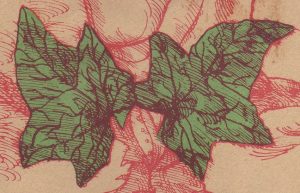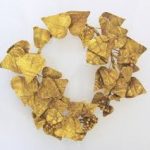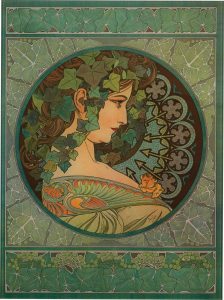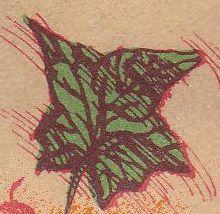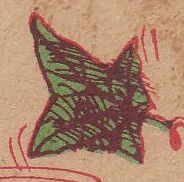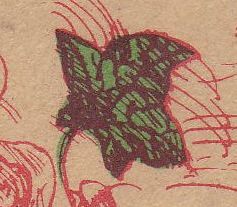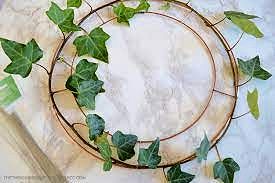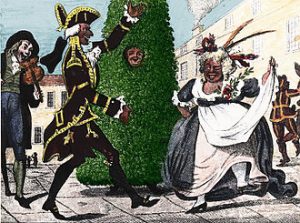ENGLISH IVY (Hedera helix)
Europe, W Asia to Iran
Glossy GREEN leaves of this climber, which we know as English Ivy, offer gardeners an evergreen backdrop for other plants. But this is also a bees’ favourite. Easy to grow all year round, Hedera helix can reach 50 feet or more in sun or shade. But you can shape its size to suit your own garden, patio, or windowbox.
The plant clings by tendrils & aerial roots, climbing up trees, walls & fences and providing ground cover. Hedera helix grows in sun or shade & is unfussy about soil, but prefers it to be alkaline & not waterlogged.
Young ivy leaves have 3 to 5 lobes, while the mature plant ( 10 yrs or older) has bushy, free-standing sprays of oval to diamond-shaped leaves. Flowers on stalks become berries late in the season, much valued by birds in winter when food is scarce.
Hedera helix is common in woods & hedges throughout Europe & western Asia. YELLOW-GREEN flowers, rich in nectar, appear during autumn on mature plants, followed by BLACK berries.
Wildlife
Hedera helix is the essential plant for a wildlife-friendly garden, according to naturalist and environmentalist Chris Baines in his book HOW TO MAKE A WILDLIFE GARDEN. Read more about this book on our Websites and Other Resources page.
” Of all the climbing plants you could possibly grow, there is no doubt in my mind about which is the best for wildlife. Ivy. No wonder the ancient Brits thought it had magical properties.
First of all, it is really very easy to grow. It likes shade best, and a reasonably rich soil, but in fact it will grow pretty well anywhere. It grows up vertical surfaces without any need for wires or bits of string, though it sometimes needs a bit of encouragement at first…
The great thing about Ivy as a wildlife climber is the variety of ways in which it supports wild creatures. Being evergreen, it provides very good cover throughout the year, of course, and an ivy-covered wall is a favourite nesting site for wrens. Blackbirds often build in older ivy, too.
Ivy is particularly important as wildlife cover in the winter, with several species of butterfly hibernating amongst its leaves…
Ivy doesnt’t stop at physical protection either. Its flowers last longer into the winter than almost any other British plant, often carrying golden blobs of sweet life-giving nectar right through into December. It only flowers once it reaches maturity, and it seems to need to climb up to at least a metre or so…
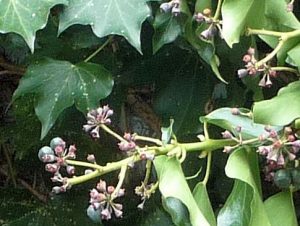 After the flowers come the fruit, and again the ivy is terrific. Most years the clusters of berry-like fruits are only ripening to their mature purple/black stage at the end of the winter, when most other natural foods such as hips and haws have been eaten up.
After the flowers come the fruit, and again the ivy is terrific. Most years the clusters of berry-like fruits are only ripening to their mature purple/black stage at the end of the winter, when most other natural foods such as hips and haws have been eaten up.
… People worry terribly about the effect on their buildings of climbers such as ivy. All sorts of stories circulate about demolished masonry. The fact is that climbers are much more likely to protect your brickwork. insulating it from the effects of frost and direct sunshine. “
Chris advises training climbers on wires or screening held in position a few inches from wall or fence. Drawing by Chris Baines shows possible places for butterfly, blackbird & snail behind a climber, held proud of a wall by wires. (Chapter 5, Hedgerows and climber-covered screens.)
Chris Baines, How to Make a Wildlife Garden, Elm Tree Books/Hamish Hamilton Ltd. 1985, Revised edition Frances Lincoln, 2000.
Two 1988 youtube videos show, step by step, how Chris did it.
The Making of a Wildlife Garden – part one – youtube/mozilla firefox https://www.youtube.com/watch?v=qG0aCIbw5Wk
The Making of a Wildlife Garden – part two – youtube/mozilla firefox https://www.youtube.com/watch?v=VDZ3-NkA8UM
If you let your Ivy grow to maturity, more wildlife can make use of it. Ivy that is constantly clipped does not flower. Insects visiting Ivy flowers include Moths, Butterflies (Red Admiral, Speckled Wood, Holly Blue & Comma), Honeybees & other bees.
In our garden, Wrens dive into the Ivy to forage for spiders and small insects, as do Robins, Sparrows & Bluetits. Ivy berries are an important food source for birds in winter, when little else may be available to them.
“Research has shown that trees with ivy growing up them accomodate more wildlife than those without. Instead of assuming that all ivy must be cut away, it is better to be pragmatic about it. Investigate first whether it is really causing any damage. Most healthy trees can withstand at least some ivy growth before being cut back. The wildlife will appreciate it!”
http://www.buzzaboutbees.net/plants-for-bees.html
‘Gardeners Urged to Let Ivy Flourish to Save Bees’
Growing ivy in gardens may help to prevent the decline of honeybees
‘Scientists have found that Ivy is one of the most important plants to provide nectar for bees. They found that honey bees rely upon ivy for the majority of the pollen and nectar they collect during the autumn months, a crucial time when the insects are trying to build up stores for the winter and feed their young.
The researchers are now urging gardeners not to rip up ivy when tidying their gardens this summer. Honeybees have suffered large declines in Britain with numbers halving in the last 25 years while wild bees such as bumblebees are also suffering.’
Richard Gray, Science Correspondent for the Telegraph, April 25 2013.
Richard Gray quotes Guy Barter, chief adviser at the RHS: ‘As gardens have become smaller, old buildings have disappeared and gardeners become more tidy minded, I suspect the amount of mature ivy has been decreasing’…
Scientists at The University of Sussex want to encourage the public to identify insects that visit Ivy flowers, to help monitor pollinator numbers. By tapping into their website you can take part, read about their work and download their pamphlet Appreciating Ivy and its Insects
http://www.sussex.ac.uk/lasi/resources/education/ivyvisitors
Traditional and Historical
Ivy was sacred to Dionysius (Bacchus), the god of wine; if bound to the brow, it was supposed to prevent intoxication. Wreaths of Ivy symbolize fidelity and were part of the marriage ceremony in ancient Greece. They were banned by the early Christian church as a pagan custom.”
RHS Encyclopedia of Herbs, Deni Bown, 2008
Dionysus is usually depicted holding a Thyrsus, a staff, sceptre or wand made from a stout, hollow fennel stem, topped with a pine cone and wound about with ivy. Revellers who worshipped the god carried these as torches, setting fire to them in the night and leading the way in wild, wine fuelled dances. Only when they are bound with ivy leaves do they truly become magic.
The Ogham Trees – Ivy – Gort _ Mozilla Firefox
Ivy in History
Using ivy as decoration also dates back to the time of the Romans, who associated it with Bacchus (the Roman equivalent of the Greek Dionysus, god of wine and intoxication). Ivy was a symbol of fidelity and marriage, and was often wound into a crown, wreath or garland. It also served as a symbol of prosperity and charity, and thus it was adopted by the early Christians, for whom it was a reminder to help the less fortunate.
In early England, it was considered bad luck to use ivy alone in decorating for Christmas, and would give the woman of the house the upper hand.
To the ancient Celts, for whom the winter solstice was cause for both celebration and fear, evergreens were a symbol of hope and rebirth. The Celts believed that by bringing evergreens indoors they were providing a haven for woodland spirits through the winter months. Evergreen plants like holly, ivy and mistletoe were thought to ward off misfortune and bring protection and luck.
Holly and ivy were the primary greens used to decorate English churches beginning no later than the 15th and 16th centuries, and were mentioned in the accounts of churchwardens of that time, according to Steve Roud, an expert on English folklore and superstition. ” Gwen Bruno, Dave’s Garden website
In ancient Egypt ivy was dedicated to Osiris, who represented immortality.
In Germany, it is traditional that ivy is only used outside and a piece tied to the outside of a church was supposed to protect it from lightning.
Greek brides wore traditional wedding veils of yellow or red, which represented fire. These brightly colored veils were supposed to protect the bride from evil spirits and demons… A Greek bride may carry a lump of sugar on her wedding day to ensure she has a sweet life, or she might carry ivy, as a symbol of endless love. Best country: Greek wedding traditions – Mozilla Firefox
Ivy is commonly associated with Christmas, along with its counterpart Holly. As evergreen species, both plants were used to ‘ward off evil spirits’, with sprigs being picked & brought inside to keep house goblins at bay. It has also been a tradition to place a sprig of ivy within a bride’s bouquet, as it is thought that ivy symbolises fidelity, loyalty and support within a marriage. Hedgerow species #8 – Ivy / Farming and Wildlife Advisory Group South West Ltd.
In the Victorian Language of Flowers, Ivy was indeed seen to symbolise fidelity and marriage.
“The plant has featured in European culture for centuries. Ivy can be found in ancient Irish, Norwegian & Germanic images, & played an important role in the past because it’s evergreen. During long winters with little light, ivy in the home offered a spark of hope that spring would come again.” https://www.thejoyofplants.co.uk/ivy”
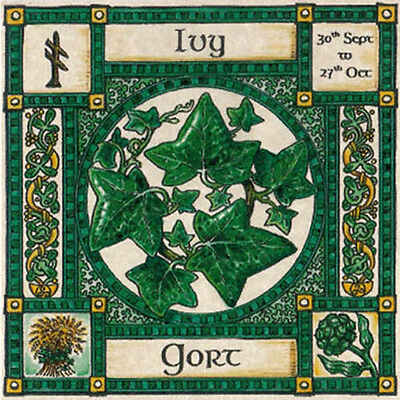 Ivy Tree Greeting Cards- Celtic 27th September – 30th October – ebay
Ivy Tree Greeting Cards- Celtic 27th September – 30th October – ebay
Hedera Helix NASA Approved
‘It has been proven by NASA (The National Aeronautics and Space Administration) that keeping English Ivy as an indoor plant could result in good air quality in your surroundings. This is because they are best at absorbing formaldehyde coming out of electronics or laptops and it also cleans up other harmful toxins. Thus, making an excellent environment for your indoor spaces.’
One of 11 Best Feng Shui Plants in India
In Feng Shui, this is one of the few plants that protects those around it. The sharp leaves are believed to block negative energies from entering homes.
The three points in each leaf are lucky since the number three is a number symbolising luck & builds stronger relationships among families. English Ivy is great for llandscaping & is one of the best air purifying plants to remove toxins from your surroundings. English Ivy thrives in the presence of carbon dioxide & therefore is the perfect city plant to cleanse the air around you.
Beauty: The beautiful vines & the delicate looking leaves add a great visual everywhere it grows.
Placement: Growing this plant on windowsills or hanging from pots allows for a lovely lush feeling of prosperity. The plant can grow both indoors & outdoors but will require a good amount of sunlight.
Main Advantages: Healing & protecting those around it, the English Ivy also allows you to get in touch with your negative emotions and spiritually heal your mind.
Special Care: The leaves are poisonous & must never be ingested. The Plant is very easy to grow. PlantDecors Blog – Mozilla Firefox
The Green Man

The Green Man pub sign, Takeley, Essex, flickr

The Green Man, John Piper, 1903 – 1992.
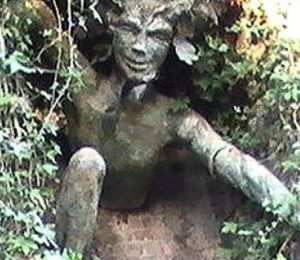
The Spriggan, Parkland Walk, Marilyn Collins

The Green Man, Spirit of the Woods, Bite Sized Britain.co.uk
Jack in the Green
The English tradition of celebrating Mayday, the first day of spring, goes back centuries. In the 17th century there were milkmaids carrying garlands of flowers… today’s annual parade in Hastings, UK, features a host of characters from chimney sweeps to King John and The Green Man, all led by Jack in the Green – a wooden structure covered with ivy and other leaves and topped with a crown…
Those in the parade are festooned with greenery to mark the official first day of spring when hope is renewed and green things grow again.
“
Jack is a colourful figure, almost 3m tall ( 9ft. 8in tall), covered in greenery and flowers. …he is accompanied by two attendants, representing the legendary figures of Robin Hood and Maid Marian. In Hastings, he is also accompanied by attendants, here known as Bogeys, who are completely disguised in green rags, vegetation and face paint. The attendants play music, dance and sing as they guide Jack through the streets to celebrate the coming of summer.” Wikipedia
“And we’re all met again on the first day of spring
To go about dancing with Jack in the Green
Jack in the Green, Jack in the Green
To go about dancing with Jack in the Green”
English folk song
Videos of the annual Mayday celebrations have been put out on youtube. This one is from Hastings 2017. Plenty of ivy here & a great burst of Mayday in under 3 minutes.
Jack in the Green, Hastings, Mayday 2017 – footage from the procession in Hastings Old Town, West Sussex

Hastings Jack in the Green parade, 2017
youtube Video by Bertrand Wattle
https://www.youtube.com/watch?v=LWfJHa_AKN8
Other names: Atlantic Ivy, Bergflétta, bentwood, bindwood, common ivy, Crimean Ivy, Efeu, European Ivy, gort, gum ivy, ifig, Irish Ivy, ivory, ivy gum plant, lablab, kissos, lovestone, love united, true ivy, winter-green, winter-grunt, woodbine.
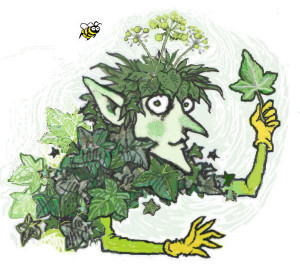 Highbury – Too Much of a Good Thing
Highbury – Too Much of a Good Thing
In our garden there is Ivy on every wall, climbing and carpeting – it seems to have its own ruling sprite, who we call Hedera Vetch. Whenever a place appears that could do with a new plant, HV will be whispering ‘Wouldn’t ivy go well here? So little maintenance, always looks smart.. a perfect backdrop for every shrub & flower…. ‘

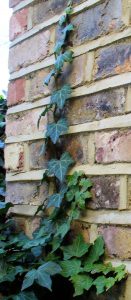 RF, our first gardener, planted Ivy along our brick walls. Over the years it has provided shelter for many creatures, berries for birds & nectar for bees in the shank of the year… Thank you, RF!
RF, our first gardener, planted Ivy along our brick walls. Over the years it has provided shelter for many creatures, berries for birds & nectar for bees in the shank of the year… Thank you, RF!
If there are changes in your life – you find yourself spending less time in the garden, or you are ill, or need to be somewhere else – be warned, Hedera helix left on its own can take over. Here, our rose became enveloped by the wall of ivy below it. Much pruning, lopping & sawing had to be done to the ivy to free the rose.

